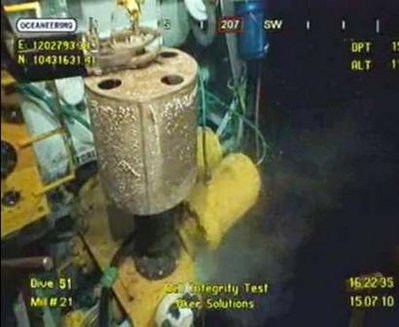World Business
BP finally stops oil spewing from Gulf gusher
(Agencies)
Updated: 2010-07-16 11:03
 |
Large Medium Small |
For nearly two months, the world's window into the disaster has been through a battery of BP cameras, known as the "spillcam." The constant stream of spewing oil became a fixture on cable TV news and web feeds.
That made it all the more dramatic on Thursday when, suddenly, it was no more.
On the video feed, the violently churning cloud of oil and gas coming out of a narrow tube thinned, and tapered off. Suddenly, there were a few puffs of oil, surrounded by cloudy dispersant that BP was pumping on top. Then there was nothing.
"Finally!" said Renee Brown, a school guidance counselor visiting Pensacola Beach, Fla., from London, Ky. "Honestly, I'm surprised that they haven't been able to do something sooner, though."
Alabama Gov. Bob Riley's face lit up when he heard the news. "I think a lot of prayers were answered today," he said.
The next 48 hours are critical. Engineers and scientists will be monitoring the cap around the clock, looking for pressure changes. High pressure is good, because it shows there's only a single leak. Low pressure, below 6,000 pounds per square inch or so, could mean more leaks farther down in the well.
Thad Allen, the retired Coast Guard admiral overseeing the spill for the government, said they are deciding as they go along whether to release oil into the water again. At the end of the 48-hour test it's possible oil will start to flow again — but, theoretically, in a controlled manner.
When the test is complete, more seafloor mapping will be done to detect any damage or deep-water leaks.
The saga has devastated BP, costing it billions in everything from cleanup to repair efforts to plunging stock prices. Though BP shares have edged upward, they shot higher in the last hour of trading on Wall Street after the company announced the oil had stopped. Shares rose $2.74, or 7.6 percent, to close at $38.92 — still well below the $60.48 they fetched before the rig explosion.
The Gulf Coast has been shaken economically, environmentally and psychologically by the hardships of the past three months. That feeling of being swatted around — by BP, by the government, by fate even — was evident in the wide spectrum of reactions to news of the capping.
"Hallelujah! That's wonderful news," Belinda Griffin, who owns a charter fishing lodge in Lafitte, La., said upon hearing the gusher had stopped. "Now if we can just figure out what to do with all the oil that's in the Gulf, we'll be in good shape."
The fishing industry in particular has been buffeted by fallout from the spill. Surveys of oyster grounds in Louisiana showed extensive deaths of the shellfish. Large sections of the Gulf Coast — which accounts for 60 to 70 percent of the oysters eaten in the United States — have been closed to harvesting, which helps explain why one oysterman in Louisiana refused to accept that progress was afoot.
Prove it, said Stephon LaFrance of Buras, La.
"I've been out of work since this happened, right? And I ain't never received nothing from BP since this oil spill happened," he said. "Like they say they stopped this oil leak. I think that's a lie. I got to see it to believe it."
Rosalie Lapeyrouse, who owns a grocery store and a shrimping operation in Chauvin, La. that cleans, boils and distributes the catch, was shocked.
"It what?" she said in disbelief. "It stopped?" she repeated after hearing the news.
"Oh, wow! That's good," she said, her face clouding. "I'm thinking they just stopped for a while. I don't think it's gonna last. They never could do nothing with it before."
Long after the out-of-control well is finally plugged, oil could still be washing up in marshes and on beaches as tar balls or disc-shaped patties. The sheen will dissolve over time, scientists say, and the slick will convert to another form.
There's also fear that months from now, oil could move far west to Corpus Christi, Texas, or farther east and hitch a ride on the loop current, possibly showing up as tar balls in Miami or North Carolina's Outer Banks.
The National Oceanic and Atmospheric Administration is expecting to track the oil in all its formations for several months after the well is killed, said Steve Lehmann, a scientific support coordinator for the federal agency.
Once the well stops actively spewing oil, the slicks will rapidly weather and disappear, possibly within a week, and NOAA will begin to rely more heavily on low-flying aircraft to search for tar balls and patties. Those can last for years, Lehmann said.
In Louisiana's Plaquemines Parish, the worst-hit area of the coast, frequent BP and government critic Billy Nungesser, the parish president, offered a word of caution: This whole mess, he said, is far from over.
"We better not let our guard down," Nungesser said. "We better not pull back the troops because, as we know, there's a lot of oil out there, on the surface, beneath it. And I truly believe that we're going to see oil coming ashore for the next couple of years."
